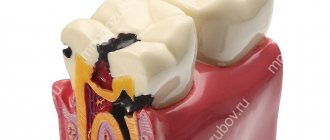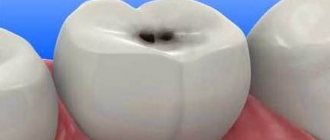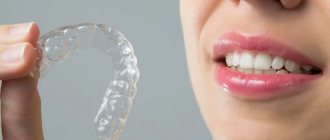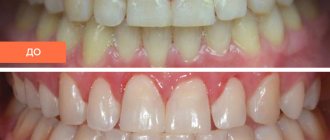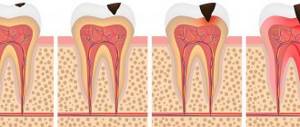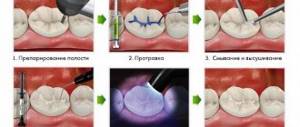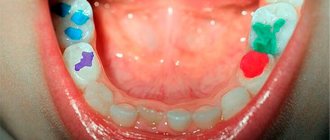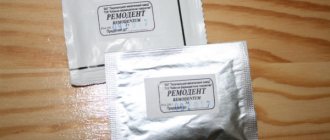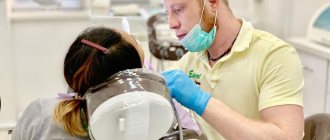Calcium is one of the common elements; the most common calcium compounds in nature are calcium carbonate and calcium phosphate. Calcium phosphate is part of human bones and teeth. The biological role of calcium in the human body is great. Deficiency and/or disturbance of calcium metabolism in childhood and adolescence can lead to the development of caries. In recent years, there has been a tendency to consider early childhood caries as a pressing pediatric problem.
Calcium deficiency is a serious cause of deterioration in dental health, especially during periods of intensive growth of the body.
Therefore, it is extremely important to additionally saturate tooth enamel with calcium and phosphate ions to reduce the risk of developing caries.
Currently, the following remineralizing gels have proven themselves to be effective:
Modern treatment of caries
Thanks to the constant improvement of techniques, today the diagnosis and treatment of dental caries is carried out at a high level, which allows for maximum preservation of healthy tissue. In addition, in situations where just a few years ago advanced caries led to mandatory tooth extraction, today tooth-preserving operations are performed. Among them are the following.
- Resection:
treatment of tooth root caries by removing the apex of the root. - Root amputation:
removal of the damaged root part of a two-rooted or three-rooted tooth. - Coronoradicular separation:
separation of tooth roots. It is carried out when caries has affected the tooth in the area of root branching. - Hemisection:
removal of the damaged part of a multi-rooted tooth and the adjacent crown area.
Indications for the treatment of dental caries
Indications are reduced to visual and tactile.
✔
Visual:
stains on the enamel, darkening of the cervical area of the tooth, chipping of part of the tooth and darkening underneath it, a dark border around the perimeter of the filling, a carious hole.
✔
Tactile:
aching pain when eating sweet, salty and sour foods, and acute pain from sudden temperature changes.
Diagnosis of caries
In some cases, caries can be treated at the initial stage, quickly recognizing it by its symptoms:
- the appearance on the surface of teeth of spots and dots from brown to black, as well as white chalky spots, signaling the beginning of destruction of tooth enamel;
- short-term pain when eating sweet or salty foods, discomfort when eating cold and hot foods and drinks;
- constant aching toothache;
- bad breath;
- coating on the tongue;
- sensations of destroyed enamel, holes, chips, sharp edges of the teeth when the tongue touches the teeth.
Types of caries by localization
fissure
It begins in the physiological recesses of the chewing teeth - fissures. The patient cannot detect it during self-examination.
Approximal (or contact)
It begins on the contacting surfaces of adjacent teeth. As a rule, this is a consequence of not using floss or irrigator as part of hygiene.
Cervical
It begins at the base of the gum, gradually destroying the neck of the tooth. It is the result of severe tartar.
Interior
It begins under the tooth filling if errors were made during its installation.
Under the crown
It begins under the crown if it does not fit tightly to the tooth, causing microscopic food debris to accumulate.
Types of caries according to severity
Initial caries
Characterized by a change in the color of the enamel: the so-called white spot caries. Does not cause discomfort to the patient.
Superficial caries
Characterized by the appearance of dark spots on the enamel. The affected tooth may react weakly to cold, sour or sweet foods for a short time.
Average caries
Characterized by destruction of dentin. Painful sensations to external stimuli are more pronounced and last longer.
Deep caries
Characterized by damage to a large area of tooth enamel and dentin. The pain does not go away without the use of analgesics.
Modern methods of treating dental caries
Today, there are several methods for treating caries, differing in the degree of surgical intervention - the earlier the degree of development of the disease, the greater the likelihood that it will be possible to get rid of it with few sacrifices.
Modern technologies for treating caries without preparation:
- Remineralization:
a procedure for treating enamel caries, which involves treating the tooth surface with a solution containing fluoride, phosphorus and calcium. The patient is also prescribed a number of medications to take orally. Helps in the treatment of white caries, or caries in the spot stage. - Infiltration:
chemical-mechanical treatment is also a method of treating caries without preparing Icon. It is used for initial caries and only on smooth surfaces or between teeth. First, a gel is applied to the carious area, which splits the affected enamel; the site of bacterial development is dried under the influence of ethyl alcohol and an air stream and treated with a polymer resin, which fills the enamel pores. The entire procedure lasts about fifteen minutes. - Air abrasive treatment:
“knocking out” superficial caries using a powerful stream of abrasive particles. The force of action is designed to affect only soft tissues affected by bacteria. The method is painless, and therefore there is no need for anesthesia. Air abrasive treatment reduces the risk of microcracks forming after treatment, in some cases it is even more effective than a drill. However, this method of caries treatment is not always applicable. - Ozone treatment:
destruction of caries bacteria using a natural antibiotic and oxidizing agent - ozone. Another method of non-contact treatment of caries. Ozone not only suppresses infection, but also has a remineralizing effect on tissue. During the procedure, a special device converts ozone from oxygen and supplies it to the affected area. Ozone destroys bacteria and is converted back into oxygen. The technology for treating caries with ozone allows you to leave healthy cells intact. Another advantage is that there is no need for anesthesia. The treatment time for caries using this method is less than a minute. Like the previous one, it is suitable only in the initial stages of caries or as its prevention. - ART technique:
restorative therapy, during which, using a special instrument, the affected tissue is removed and the cavity is filled with special dental cement. This method of treating caries was invented in third world countries, where it was not possible to open full-fledged dental offices, but it is also used in developed countries. Completely manual work allows you to act carefully and preserve as much healthy tissue as possible. - Laser treatment:
an effective technique for eliminating superficial and intermediate caries (for example, in the treatment of dentin caries) using laser fluorescence. During the procedure, a bactericidal solution is used, which cools the tooth and reduces pain. In addition, laser devices do not produce vibrations, which could increase pain. That is why the laser treatment method is indicated primarily for children and pregnant women. The laser selectively acts on the affected area, “evaporating” it, and disinfects the resulting cavity, thus eliminating the risk of developing secondary caries. - Treatment of dental caries with diet:
a method of treating caries naturally, developed based on the scientific theory of the American researcher Ramiel Nagel. According to his observations, caries does not have an infectious-bactericidal nature, but is associated with the weakening and destruction of enamel due to a lack of necessary substances. Therefore, the problem can be solved with proper nutrition. Adherents of natural treatment recommend actively using cod liver, fish caviar, butter and other products containing fat-soluble vitamins, nutritious broths, as well as chicken, beef and fish. It is better not to overuse fruits - due to their high sugar content - and combine them with small portions of fat, such as cream.
How to clean teeth from caries
People don't like going to the dentist, that's a fact. Only this can explain such a widespread prevalence of caries. According to unofficial statistics, about 98% of the world's population suffers from this dental disease. And this despite the fact that with proper daily hygiene and professional cleaning of the oral cavity by a dentist at least once every six months, cariogenic bacteria would have no chance.
The proposed material discusses the basic principles of caries prevention and the algorithm for treating the disease depending on the stage of the pathological process. We will devote a little time to the reasons for the development of pathology, since this is necessary to understand the principles of organizing the preventive process.
Causes of caries
The first question we must ask ourselves is, what is tooth decay? This is a dental disease in which tooth enamel and dentin are destroyed. The order of development of the pathological process is exactly this: first, the carious defect develops in the enamel, and then moves to deeper dentin tissue. With a complicated disease, pathogenic bacteria penetrate even deeper into the soft tissues, and pulpitis develops.
The cause of caries is the development of pathogenic microflora, first on the surface of the enamel, and then in the dental tissues themselves. Bacteria that can cause the development of this disease are usually called cariogenic. This is a large group of microorganisms, many of which are opportunistic and constantly live in the oral cavity.
The cause of caries is the destruction of tooth enamel, and then dentin, by cariogenic microflora!
It is legitimate to talk about predisposing factors that contribute to the development of the disease. The first and most important is poor oral hygiene. Improper or irregular dental care creates the preconditions for the development of pathogenic bacteria. The more soft plaque or tartar on the teeth, the higher the risk of carious destruction.
Another group of predisposing factors is associated with certain conditions of the body. The main manifestation of the first stage of caries development is a decrease in mineralization (reduction in the amount of calcium) of tooth enamel with the formation of first a light and then a brown spot on its surface. Diseases of the endocrine system and other systemic diseases that are accompanied by impaired mineral metabolism contribute to the development of demineralization.
Demineralization can be accelerated by a lack of certain essential substances in the diet. We are not talking about calcium - there is just enough of it in foods. Much more often, doctors diagnose one degree or another of vitamin D deficiency. This vitamin is produced in the skin under the influence of ultraviolet radiation and plays a vital role in mineral metabolism. Vitamin D is low in foods, so if you rarely get exposure to the sun, you need to take it in the form of dietary supplements. It is also beneficial to take vitamin D (in the form of D-3) during the winter months.
Stages of the disease
The disease goes through several stages. Treatment of caries at home (assuming that this is possible, although this is not so) is allowed only at the white/brown spot stage. With superficial, and even more so, medium and deep damage to dental tissues, it is impossible to treat without the help of a specialist. This is a direct road to tooth loss and subsequent expensive dentures!
1. White/brown spot stage.
At this stage there is still no destruction of dental tissues; there is only pronounced demineralization of tooth enamel. The loss of calcium is manifested by the formation of a lightened area on the surface of the dental crown. It can be matte, bright or chalky, but the shade of the stain in any case is different from the color of healthy teeth. Severe pain is not typical for this phase; the patient may only be concerned about increased sensitivity when eating certain foods or cold/hot drinks.
As calcium salts are washed out of the dental tissues, the enamel becomes more and more porous, and food pigments begin to be deposited in it. As a result, the stain becomes brownish in color. This is still the initial stage of the disease, but the tooth is already on the verge of destruction.
2. Stage of superficial carious defect.
If the patient does not seek help at the white spot stage, a carious defect is formed - an area of destroyed enamel. Damaged dental tissue can only be restored using direct restoration, that is, filling. The defect will not heal on its own, and it is no longer possible to cure caries at home. Moreover, treatment with folk remedies can be harmful - a person will have the feeling that he is taking effective measures, although in reality the disease progresses and spreads to deep tissues.
3. Stage of average caries.
Unfortunately, carious destruction often spreads deep into the tooth, because people do not like to go to the dentist and prefer to use simple, albeit absolutely useless, folk remedies. We can talk about average caries when the carious cavity extends beyond the tooth enamel and affects the dentin.
Obviously, if it is impossible to cure the superficial form at home, then with carious damage to dentin, talking about self-treatment is even more pointless. There is no need to hope for a miracle and be treated with folk remedies, including rinsing with herbal tinctures and solutions. The algorithm of actions for the moderate form of the disease will be described in the next section of the article.
4. Stage of deep carious defect.
The development of a deep carious defect is indicated when a thin septum remains between the dentin and the pulp. In fact, the tissue of the crown is destroyed to its entire depth, and only a thin layer of still preserved dentin protects it from the penetration of cariogenic flora into the pulp.
5. Pulpitis
- complication. When cariogenic bacteria penetrate the pulp (soft tissue containing blood vessels and nerves), a complication of caries develops - pulpitis. A person feels severe toothache, which is practically not relieved by conventional analgesics. At this stage, since there is simply no other choice, many turn to a dentist for qualified help, although this should have been done much earlier. Pulpitis therapy is a much more complex, lengthy and expensive process. An uncomplicated form of the disease can be cured faster and cheaper.
How to treat caries
We start from the first stage, when the disease manifests itself in the form of a white or brown spot. How to cure caries at the initial stage of development of the pathological process? The main task is to restore enamel mineralization, that is, to compensate for calcium deficiency. In theory, you can try to do this at home. To do this, you need to brush your teeth with medicated toothpaste with a high content of calcium and fluoride, and also use special dental gels enriched with these compounds.
Unfortunately, self-medication at home does not always give the desired result. This is explained by the fact that even in the best toothpaste the concentration of active elements is lower than in professional products used by a dentist. In addition, an essential condition for success is cleansing the oral cavity from plaque and tartar, and this can only be done in a dental office equipped with an ultrasonic or Air Flow cleaning apparatus.
The correct algorithm looks like this. If an area of enamel lightening appears, you need to make an appointment with a dentist, undergo a teeth cleaning procedure and receive qualified assistance aimed at remineralizing the enamel. At the same time, you can brush your teeth with medicated toothpaste and rinse your mouth with various traditional medicines, for example, solutions of sage, chamomile or calendula.
Without cleaning teeth from plaque, caries treatment will be ineffective!
As an additional measure, it is recommended to take vitamin D, but only in its active form - D-3. It is sold at any pharmacy and is inexpensive. Taking the vitamin in a dosage of 400-800 IU per day will benefit everyone, not just patients with dental diseases.
Treatment of superficial caries
The only effective method is to remove the dental tissue affected by the pathological process, followed by filling the defect. Therefore, the question of how to get rid of caries at home is no longer relevant, unless you have a dental unit and a set of filling materials at home.
The good news is that dental care can be done in one visit to the dentist. The doctor will clean the teeth of plaque and stone, drill out a small area of enamel affected by caries, and place a filling made of photopolymer material. The cost of the procedure is low, since there is no need to depulpate the tooth and seal the root canals, as in the pulpitis stage.
Treatment of medium and deep forms
As in the case of a superficial carious defect, the basis of therapy is the removal of infected and destroyed tissues, followed by restoration of the crown using direct restoration (filling). The key differences relate to the method of preparing the tooth for filling.
With medium and deep lesions, the process spreads to the dentinal tissue. The distance between the carious cavity and the pulp is reduced, which increases the risk of developing pulpitis due to the penetration of microflora into the soft tissue. Therefore, in case of average caries, after drilling out all pathologically changed tissues, an insulating pad is placed on the bottom of the carious cavity. In case of deep damage, the dentist first places a therapeutic pad, and then an insulating one.
Before filling, the carious cavity is treated with powerful antiseptics. The purpose of this manipulation is to kill all microflora, which can lead to the development of relapse. Cariogenic bacteria are resistant to antibiotics in 99% of cases. To destroy them, strong topical agents are used.
After treatment with antiseptic solutions and isolation of the carious cavity from soft tissues, filling is performed. The doctor places a filling made of a light-curing polymer material, restoring the aesthetics and function of the diseased tooth.
If the tooth is more than half destroyed, direct restoration will not be effective enough. The patient may be recommended to reconstruct the coronal part of the tooth with a restorative inlay or through dentures - installing an artificial crown made of ceramic, zirconium or metal ceramics on the tooth stump.
These orthopedic treatment options require preliminary depulpation of the tooth, which significantly increases its final cost. You also need to add the cost of artificial crowns to the price. It is obvious that treating caries in the early stages not only allows you to preserve a living tooth, but also significantly reduces the cost of dental care.
Treatment of pulpitis
It is much more difficult to cure caries complicated by pulpitis. Typically, two, three or even four visits to the dental clinic are required. At the first visit, the doctor drills out the affected dental tissues, removes blood vessels and nerves from the root canals, treats the canals with an antiseptic solution and places a temporary filling.
At the second visit, the temporary filling is removed, the canals are re-treated with an antiseptic and sealed with dental sealant. Sealing the canals is a key condition for successful treatment of pulpitis. If voids remain in the canal, the risk of infection, post-filling pain and relapse increases.
On the third visit, after the dental sealant has completely hardened, a direct restoration of the coronal part of the tooth is performed with a light-curing polymer. Some dentists place a filling on the second visit, but this is the wrong strategy, chosen to save time. It is better to install the seal after the sealant has completely hardened, which takes several days.
conclusions
Treatment of caries should be left to professionals. You should contact the dental clinic at the white spot stage - this will preserve living tissue in full, speed up treatment and reduce its cost. Various self-help options with folk remedies are suitable only as additional measures, as well as the use of medicated toothpaste.
Effective prevention of caries consists of proper daily cleaning of teeth from plaque and food particles using high-quality toothpaste, floss and, if possible, an irrigator. It is also necessary to sanitize the oral cavity at the dentist once every six months. The procedure is combined with a preventive examination, which is very important for the timely and earliest possible diagnosis of dental diseases.
If you still have questions about caries treatment methods, ask them to a qualified medical dentist during your consultation.
Classical treatment of caries in permanent teeth
In advanced cases, non-invasive treatment methods for caries will not help, so specialists turn to the old but effective removal of caries using drilling.
The procedure involves cleaning the affected canals using a drill; if dentin is damaged, pulp and infected tooth tissue can also be removed. It should be noted that the devices that are used for this today have gone far ahead of those that once brought fear to our grandparents. Anesthesia and disinfectants can reduce the pain effect and make the procedure more comfortable for the patient. To complete the treatment of caries, a filling or crown is placed on the tooth and adjusted so that the patient does not feel any discomfort.
There are also separate types of caries:
- Cervical caries.
Tooth damage occurs in the neck of the tooth. Treatment is complicated by the proximity of the gums to the site of inflammation.
- Milk caries.
This disease can develop on children's baby teeth as a result of insufficient hygiene and care of the teeth and oral cavity. Children's teeth are easily exposed to bacteria, especially if the child consumes foods high in carbohydrates: sweets, carbonated drinks. Some parents do not attach much importance to the disease of baby teeth, believing that there is no need to treat teeth that will soon be replaced by permanent ones. However, one should take into account the fact that milk caries is a source of bacteria that can provoke diseases of the ENT organs, the digestive system, and also provoke infection during the eruption of permanent teeth.
Main stages of the procedure
If for caries in the stain stage, treatment comes down to brushing the teeth with a special brush, applying a remineralizing composition and taking medications to strengthen the enamel, then in later stages it is necessary to remove the affected tissue and fill the cavity. In this scenario, the principle of caries treatment is as follows:
- anesthesia;
- preparation of a carious cavity;
- removal of infected tissue;
- cavity treatment;
- tooth filling.
Caries treatment and filling are carried out in one appointment. If, during the treatment of caries, damage to the dental pulp is detected, it may require its removal.
Causes of caries
Nature has provided a protective mechanism for the oral cavity and teeth with the help of saliva, the compounds of which actively fight the proliferation of bacteria and viruses. However, with various malfunctions in the body and exposure to negative factors, its protective properties can be significantly reduced, making teeth vulnerable to infection.
The main causes of caries can be:
- excessive consumption of carbohydrate foods, which promote the growth of bacteria;
- deficiency of vitamins and minerals, in particular calcium and fluorine, necessary to strengthen the enamel;
- consumption of hot and cold foods and drinks that cause temperature changes and destruction of enamel;
- poor oral hygiene, irregular cleaning of teeth and cavities;
- decreased immunity of the body due to illness, stress, overwork;
- special conditions of women: pregnancy, lactation, during which the consumption of calcium and fluoride for the child’s nutrition increases;
- neglecting to visit the dentist.
Choosing a filling
Previously, mainly mineral cements, acrylic and epoxy, and amalgams were used to make fillings. Today, outdated fillings, which were imperfect in terms of fixation and aesthetics, have been replaced by modern inlays. They improve the adhesion strength to the tooth surface, do not require labor-intensive installation, and are biocompatible with the human body. Among them, the most used are: composites, glass ionomer cements, ormocers, compomers. Materials can be combined to achieve the desired effect.
Is it possible to cure tooth decay at home?
Treatment of dental caries at home is impossible. However, this disease is preventable. To do this, you should regularly perform oral hygiene using calcium and fluoride toothpaste, visit the dentist twice a year and ensure that your diet contains enough proteins and fewer carbohydrates. For additional protection, you can apply gels to strengthen tooth enamel, which will saturate the teeth with minerals - they are not a cure for caries, but will help reduce the risk of developing the disease.
If it is too late to prevent caries, then herbal compresses and rinsing with strong tea will help temporarily reduce the intensity of pain. You can also press on the area between the lips and nose - there is a point there, the impact of which will send signals to the brain that distract it from the main source of pain. However, instead of diligently practicing traditional healing, it is better to turn to a professional as soon as possible. After all, only he will help you effectively cope with the problem.
Professional gels and toothpastes for caries
Restores damaged areas of enamel and reduces tooth sensitivity. Recommended for erosion of tooth enamel, exposed tooth neck, after removal of orthodontic structures, before the whitening procedure.
It contains fluorides, which promote mineralization of tooth enamel and help prevent caries.
Promotes tissue regeneration, accelerates wound healing. Has anti-inflammatory, antioxidant, immunostimulating effects.
Indicated for multiple caries, non-carious lesions (fluorosis, hypoplasia, wedge-shaped effect), pathological abrasion of teeth, pregnancy, orthodontic treatment.
The bioavailable calcium and phosphorus included in the composition revive the enamel. Useful minerals reduce sensitivity and strengthen teeth, and milk protein stops tooth decay. Used as a means of caries prevention. The mousse is applied twice a day after brushing your teeth.
Cost of caries treatment in Moscow
The cost of caries treatment in each specific case is calculated individually and consists of several components:
- what type of filling will be installed;
- what type of anesthesia will be used;
- how much work the doctor has to do.
Thus, installing a filling on a chewing tooth affected by caries in state dentistry can cost 900 rubles, since it involves the cheapest composite material. The cost of a light filling in a private dental clinic in Moscow varies between 1500 – 2500 rubles. Treatment of caries of anterior teeth exceeds 3,000 rubles, since there are increased demands on aesthetics. As for anesthesia, local anesthesia starts at 300 rubles per tooth, general anesthesia starts at 2,000 rubles, and treatment with sedation, depending on its degree, ranges from 3,000 to 15,000 rubles.
